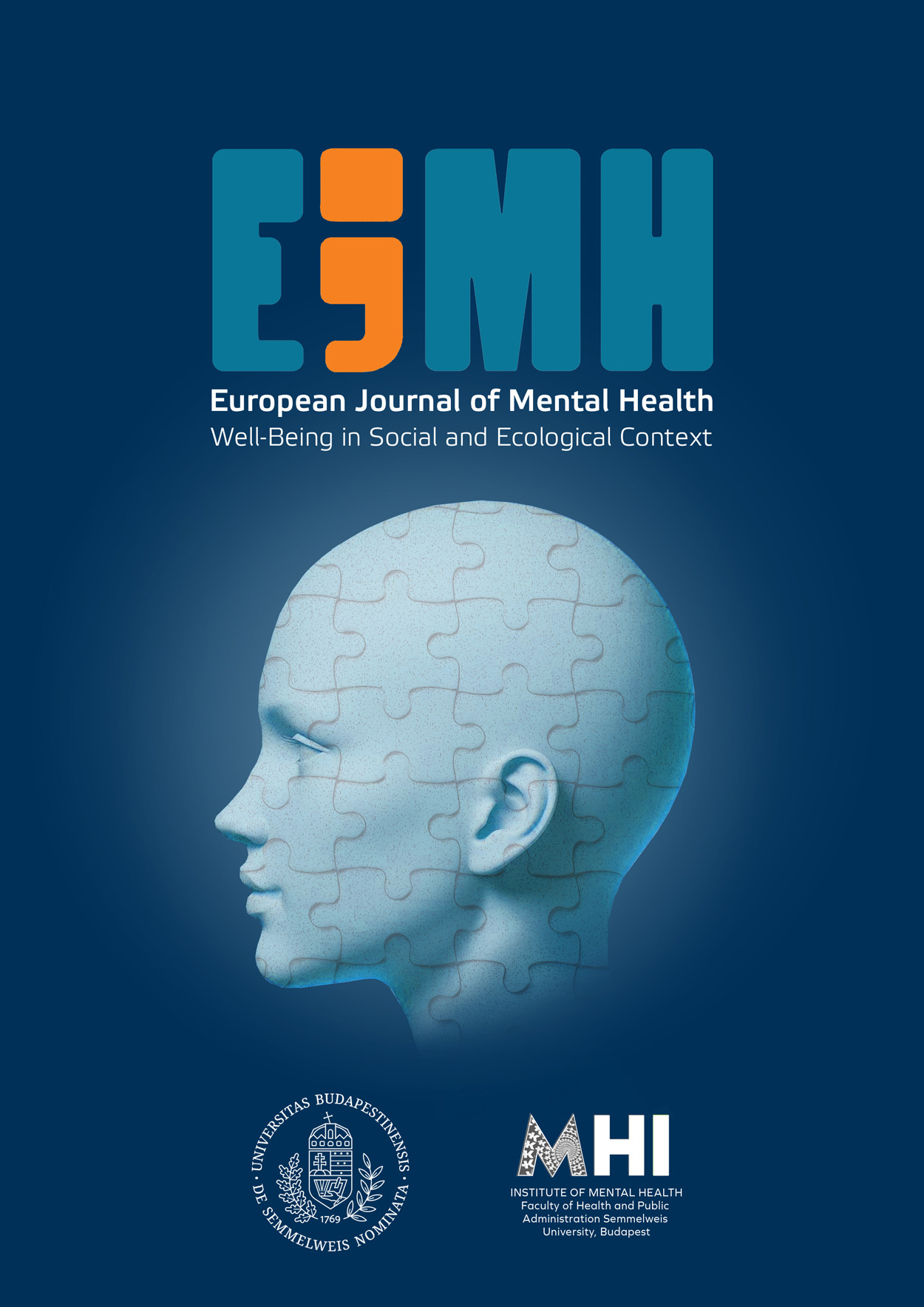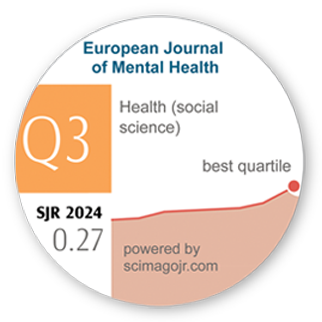Adolescents’ Perceptions About Non-suicidal Self-injury, Suicidal Ideation and Suicide Attempts
DOI:
https://doi.org/10.5708/EJMH.18.2023.0004Keywords:
adolescence, non-suicidal self-injury, suicidal ideation, suicide attempts, free word associationAbstract
Introduction: Non-suicidal self-injury, suicidal thoughts and behaviors present high prevalence rates in adolescence.
Aims: This study aimed to describe adolescents’ perceptions about these phenomena, and to analyze and compare the differences of these perceptions among adolescents with and without a history of non-suicidal selfinjury, suicidal ideation, and suicide attempts.
Methods: The convenience sample consisted of 452 adolescents in ages between 12 and 18 (M(SD) = 15.59(1.50), 48% male and 52% female. For data collection, the Free Association Test was used in a survey, and data was analyzed through content analysis.
Results: Results showed that 10.8% of the participants presented a history of non-suicidal self-injury, 19.9% suicidal ideation, and 2.7% suicide attempts. Perceptions were grouped into eight dimensions: Consumption of Psychoactive Substances; Death/Suicide; Interpersonal Factors; Intrapersonal Factors; Moral Judgments; Negative Emotions; Psychological Functions; and Self-Injurious Methods. Further analysis revealed that adolescents with and without a history of non-suicidal self-injury, suicidal ideation, and suicide attempts presented differences in their perceptions of these phenomena.
Conclusions: These findings contribute to the understanding regarding the perceptions of adolescents about these phenomena and might have implications regarding their prevention and intervention.
References
Arnautovska, U., & Grad, O. T. (2010). Attitudes toward suicide in the adolescent population. Crisis: The Journal of Crisis Intervention and Suicide Prevention, 31(1), 22–29.
https://doi.org/10.1027/0227-5910/a000009
Azevedo, A., & Matos, A. P. (2014). Ideação suicida e sintomatologia depressiva em adolescentes [Suicidal ideation and depressive symptomatology in adolescents]. Psicologia, Saúde & Doenças, 15(1), 180–191.
https://estudogeral.uc.pt/handle/10316/47295
Baetens, I., Claes, L., Onghena, P., Grietens, H., Van Leeuwen, K., Pieters, C., Wiersema, J. R., & Griffith, J. W. (2015). The effects of nonsuicidal self-injury on parenting behaviors: A longitudinal analysis of the perspective of the parent. Child and Adolescent Psychiatry and Mental Health, 9, 24.
https://doi.org/10.1186/s13034-015-0059-2
Bardin, L. (2008). Análise de Conteúdo [Content Analysis]. Edições 70.
Batejan, K. L., Swenson, L. P., Jarvi, S. M., & Muehlenkamp, J. J. (2015). Perceptions of the functions of nonsuicidal self-injury in a college sample. Crisis: The Journal of Crisis Intervention and Suicide Prevention, 36(5), 338–344.
https://doi.org/10.1027/0227-5910/a000332
Bazrafshan, M. R., Sharif, F., Molazem, Z., & Mani, A. (2016). Exploring the risk factors contributing to suicide attempt among adolescents: A qualitative study. Iranian Journal of Nursing and Midwifery Research, 21(1), 93–99.
https://doi.org/10.4103/1735-9066.174747
Bilsen, J. (2018). Suicide and youth: Risk factors. Frontiers in Psychiatry, 9, 540.
https://doi.org/10.3389/fpsyt.2018.00540
Biswas, T., Scott, J. G., Munir, K., Renzaho, A. M. N., Rawal, L. B., Baxter, J., & Mamun, A. A. (2020). Global variation in the prevalence of suicidal ideation, anxiety and their correlates among adolescents: A population based study of 82 countries. EClinicalMedicine, 24, Article 100395.
https://doi.org/10.1016/j.eclinm.2020.100395
Bresin, K., Sand, E., & Gordon, K. H. (2013). Non-suicidal self-injury from the observer's perspective: A vignette study. Archives of Suicide Research, 17(3), 185–195.
https://doi.org/10.1080/13811118.2013.805636
Calati, R., Ferrari, C., Brittner, M., Oasi, O., Olié, E., Carvalho, A. F., & Courtet, P. (2019). Suicidal thoughts and behaviors and social isolation: A narrative review of the literature. Journal of Affective Disorders, 245, 653–667.
https://doi.org/10.1016/j.jad.2018.11.022
Carvalho, C. B., Motta, C., Sousa, M., & Cabral, J. (2017). Biting myself so I don’t bite the dust: Prevalence and predictors of deliberate self-harm and suicide ideation in Azorean youths. Revista Brasileira de Psiquiatria, 39(3), 252–262.
https://doi.org/10.1590/1516-4446-2016-1923
Chu, C., Podlogar, M. C., Rogers, M. L., Buchman-Schmitt, J. M., Negley, J. H., & Joiner, T. E. (2016). Does suicidal ideation influence memory? A study of the role of violent daydreaming in the relationship between suicidal ideation and everyday memory. Behavior Modification, 40(5), 731–747.
https://doi.org/10.1177/0145445515625189
Cipriano, A., Cella, S., & Cotrufo, P. (2017). Nonsuicidal self-injury: A systematic review. Frontiers in Psychology, 8, 1946.
https://doi.org/10.3389/fpsyg.2017.01946
Duarte, E., Gouveia-Pereira, M., & Gomes, H.S. (2019a). Development and factorial validation of the Inventory of Deliberate Self-Harm Behaviours for Portuguese adolescents. Psychiatric Quarterly, 90, 761–776.
https://doi.org/10.1007/s11126-019-09660-1
Duarte, E., Gouveia-Pereira, M., Gomes, H. S., & Sampaio, D. (2019b). Social representations about the functions of deliberate self-harm: Adolescents and parents. Journal of Adolescence, 73(1), 113–121.
https://doi.org/10.1016/j.adolescence.2019.05.001
Duarte, E., Gouveia-Pereira, M., & Sampaio, D. (2019c). Social representations about the functions of deliberate self-harm from adults and adolescents: A qualitative study. Trends in Psychology, 27(4), 879–894.
https://dx.doi.org/10.9788/tp2019.4-05
Evans, R., White, J., Turley, R., Slater, T., Morgan, H., Strange, H., & Scourfield, J. (2017). Comparison of suicidal ideation, suicide attempt and suicide in children and young people in care and non-care populations: Systematic review and meta-analysis of prevalence. Children and Youth Services Review, 82, 122–129.
https://doi.org/10.1016/j.childyouth.2017.09.020
Fortune, S., Sinclair, J., & Hawton, K. (2008). Adolescents’ views on preventing self-harm. Social Psychiatry and Psychiatric Epidemiology, 43, 96–104.
https://doi.org/10.1007/s00127-007-0273-1
Gaspar, S., Reis, M., Sampaio, D., Guerreiro, D., & de Matos, M. G. (2019) Non-suicidal self-injuries and adolescents high risk behaviours: Highlights from the Portuguese HBSC study. Child Indicators Research, 12, 2137–2149.
https://doi.org/10.1007/s12187-019-09630-w
Georgiades, K., Boylan, K., Duncan, L., Wang, L., Colman, I., Rhodes, A. E., Bennett, K., Comeau, J., Manion, I., Boyle, M. H., & 2014 Ontario Child Health Study Team (2019). Prevalence and correlates of youth suicidal ideation and attempts: Evidence from the 2014 Ontario Child Health Study. The Canadian Journal of Psychiatry, 64(4), 265–274.
https://doi.org/10.1177/0706743719830031
Gonçalves, S. F., Martins, C., Rosendo, A. P., Machado, B. C., & Silva, E. (2012). Self-injurious behavior in Portuguese adolescents. Psicothema, 24(4), 536–541.
https://www.psicothema.com/pdf/4050.pdf
Grimmond, J., Kornhaber, R., Visentin, D., & Cleary, M. (2019). A qualitative systematic review of experiences and perceptions of youth suicide. PLOS ONE, 14(6), e0217568.
https://doi.org/10.1371/journal.pone.0217568
Hasking, P., Rees, C. S., Martin, G., & Quigley, J. (2015). What happens when you tell someone you self-injure? The effects of disclosing NSSI to adults and peers. BMC Public Health, 15, Article 1039.
https://doi.org/10.1186/s12889-015-2383-0
Hawton, K., Harriss, L., Hall, S., Simkin, S., Bale, E., & Bond, A. (2003). Deliberate self-harm in Oxford, 1990-2000: A time of change in patient characteristics. Psychological Medicine, 33(6), 987–995.
https://doi.org/10.1017/S0033291703007943
Hawton, K., Saunders, K. E. A., & O’Connor, R. C. (2012). Self-harm and suicide in adolescents. The Lancet, 379(9834), 2373–2382.
https://doi.org/10.1016/S0140-6736(12)60322-5
Hegerl, U. (2016). Prevention of suicidal behavior. Dialogues in Clinical Neuroscience, 18(2), 183–190.
https://dx.doi.org/10.31887/DCNS.2016.18.2/uhegerl
Hollinger, J. M. (2016). Adolescent attitudes toward and perceptions of suicide, stigma, and help-seeking behavior. (Paper No. 360) [Doctoral Dissertation, Philadelphia College of Osteopathic Medicine, Department of Psychology] PCOM Psychology Dissertations.
Holt, M. K., Vivolo-Kantor, A. M., Polanin, J. R., Holland, K. M., DeGue, S., Matjasko, J. L., Wolfe, M., & Reid, G. (2015). Bullying and suicidal ideation and behaviors: A meta-analysis. Pediatrics, 135(2), e496–e509.
https://doi.org/10.1542/peds.2014-1864
Joe, S., Romer, D., & Jamieson, P. E. (2007). Suicide acceptability is related to suicide planning in U.S. adolescents and young adults. Suicide and Life-Threatening Behavior, 37(2), 165–178.
https://dx.doi.org/10.1521/suli.2007.37.2.165
Klonsky, E. D. (2007). The functions of deliberate self-injury: A review of the evidence. Clinical Psychology Review, 27(2), 226–239.
https://doi.org/10.1016/j.cpr.2006.08.002
Klonsky, E. D., Glenn, C. R., Styer, D. M., Olino, T. M., & Washburn, J. J. (2015). The functions of nonsuicidal self-injury: Converging evidence for a two-factor structure. Child and Adolescent Psychiatry and Mental Health, 9, Article 44.
https://doi.org/10.1186/s13034-015-0073-4
Knorr, A. C., Ammerman, B. A., Hamilton, A. J., & McCloskey, M. S. (2019). Predicting status along the continuum of suicidal thoughts and behavior among those with a history of nonsuicidal self-injury. Psychiatry Research, 273, 514–522.
https://doi.org/10.1016/j.psychres.2019.01.067
Kranzler, A., Fehling, K. B., Anestis, M. D., & Selby, E. A. (2016). Emotional dysregulation, internalizing symptoms, and self-injurious and suicidal behaviors: Structural equation modeling analysis. Death Studies, 40(6), 358–366.
https://doi.org/10.1080/07481187.2016.1145156
Merten, T. (1992). O teste de associação de palavras na psicologia e psiquiatria: História, método e resultados [The word association test in psychology and psychiatry: History, method and results]. Análise Psicológica, 10, 531–541.
Mettler, J., Stern, M., Lewis, S. P., & Heath N. L. (2021). Perceived vs. actual emotion reactivity and regulation in individuals with and without a history of NSSI. Frontiers in Psychology, 12, Article 612792.
https://doi.org/10.3389/fpsyg.2021.612792
Muehlenkamp, J. J., Claes, L., Havertape, L., & Plener, P. L. (2012). International prevalence of adolescent non-suicidal self-injury and deliberate self-harm. Child and Adolescent Psychiatry and Mental Health, 6, Article 10.
https://doi.org/10.1186/1753-2000-6-10
Nobre-Lima, L., Barreira, A., & Castilho, P. (2018). A influência de fatores sociodemográficos na expressão de comportamentos autolesivos não suicidários (NSSI) em adolescentes portugueses [The influence of sociodemographic factors on the expression of non-suicidal deliberate self-harm (NSSI) in Portuguese adolescents]. Revista de Psicologia da Criança e do Adolescente, 8(1), 33–48. Retrieved from
http://revistas.lis.ulusiada.pt/index.php/rpca/article/view/2476
Nock, M. K., Green, J. G., Hwang, I., McLaughlin, K. A., Sampson, N. A., Zaslavsky, A. M., & Kessler, R. C. (2013). Prevalence, correlates, and treatment of lifetime suicidal behavior among adolescents: Results from the National Comorbidity Survey Replication Adolescent Supplement. JAMA Psychiatry, 70(3), 300–310.
https://doi.org/10.1001/2013.jamapsychiatry.55
Nock, M. K., & Prinstein, M. J. (2004). A functional approach to the assessment of self-mutilative behavior. Journal of Consulting and Clinical Psychology, 72(5), 885-890.
https://doi.org/10.1037/0022-006x.72.5.885
O’Connor, R. C., & Nock, M. K. (2014). The psychology of suicidal behaviour. The Lancet Psychiatry, 1(1), 73–85.
https://doi.org/10.1016/S2215-0366(14)70222-6
Oexle, N., & Rüsch, N. (2018). Stigma – Risikofaktor und Konsequenz suizidalen Verhaltens. Implikationen für die Suizidprävention. [Stigma-risk factor and consequence of suicidal behavior: Implications for suicide prevention]. Der Nervenarzt, 779–783.
https://doi.org/10.1007/s00115-017-0450-8
Oliveira, A., Amâncio, L., & Sampaio, D. (2001). Arriscar morrer para sobreviver: Olhar sobre o suicídio adolescente [Risking death to survive: A look at adolescent suicide]. Análise Psicológica, 19(4), 509–521.
https://dx.doi.org/10.14417/ap.382
Pereira, A., & Cardoso, F. (2015). Suicidal ideation in university students: Prevalence and association with school and gender. Paidéia (Ribeirão Preto), 25(62), 299–306.
https://doi.org/10.1590/1982-43272562201503
Rogers, M. L., Hagan, C. R., & Joiner, T. E. (2018). Examination of interoception along the suicidality continuum. Journal of Clinical Psychology, 74(6), 1004–1016.
https://doi.org/10.1002/jclp.22564
Sampaio, D., Oliveira, A., Vinagre, M. D. G., Gouveia-Pereira, M., Santos, N., & Ordaz,
(2000). Representações sociais do suicídio em estudantes do ensino secundário [Social representations of suicide in secondary school students]. Análise Psicológica, 18(2), 139–155.
Sampasa-Kanyinga, H., Dupuis, L. C., & Ray, R. (2017). Prevalence and correlates of suicidal ideation and attempts among children and adolescents. International Journal of Adolescent Medicine and Health, 29(2).
https://doi.org/10.1515/ijamh-2015-0053
Schlichthorst, M., Ozols, I., Reifels, L., & Morgan, A. (2020). Lived experience peer support programs for suicide prevention: A systematic scoping review. International Journal of Mental Health Systems, 14.
https://doi.org/10.1186/s13033-020-00396-1
Soto-Sanz, V., Piqueras, J. A., Perez-Vazquez, M. T., Rodriguez-Jimenez, T., Castellvi, P., Miranda-Mendizabal, A., ... & Gabilondo, A. (2019). Self-esteem and suicidal behaviour in youth: A meta-analysis of longitudinal studies. Psicothema, 31(3), 246–254.
https://doi.org/10.7334/psicothema2018.339
Stewart, J. G., Esposito, E. C., Glenn, C. R., Gilman, S. E., Pridgen, B., Gold, J., & Auerbach, R. P. (2017). Adolescent self-injurers: Comparing non-ideators, suicide ideators, and suicide attempters. Journal of Psychiatric Research, 84, 105-112.
https://doi.org/10.1016/j.jpsychires.2016.09.031
Taylor, P. J., Jomar, K., Forrester, R., Shahmalak, U., Dickson, J. M., & Dhingra, K. (2019). A meta-analysis of the prevalence of different functions of non-suicidal self-injury. Journal of Affective Disorders, 227, 759–769.
https://doi.org/10.1016/j.jad.2017.11.073
Uddin, R., Burton, N. W., Maple, M., Khan, S. R., & Khan, A. (2019). Suicidal ideation, suicide planning, and suicide attempts among adolescents in 59 low-income and middle-income countries: A population-based study. The Lancet Child & Adolescent Health, 3(4).
https://doi.org/10.1016/S2352-4642(18)30403-6
Vala, J. (1999). A análise de conteúdo [The content analysis]. In A. S. Silva, & J. Madureira Pinto (Eds.), Metodologia das Ciências Sociais [Social Sciences Methodolody]. Edições Afrontamento.
Vieira, K. F. L., & Coutinho, M. D. P. D. L. (2008). Representações sociais da depressão e do suicídio elaboradas por estudantes de psicologia [Social representations of depression and suicide elaborated by psychology students]. Psicologia: Ciência e Profissão, 28(4), 714-727.
https://doi.org/10.1590/S1414-98932008000400005
Wang, Y. H., Shi, Z. T., & Luo, Q. Y. (2017). Association of depressive symptoms and suicidal ideation among university students in China: A systematic review and meta-analysis. Medicine (Baltimore), 96(13).
https://doi.org/10.1097/md.0000000000006476
Wasserman, D., Hoven, C. W., Wasserman, C., Wall, M., Eisenberg, R., Hadlaczky, G., Kelleher, I., Sarchiapone, M., Apter, A., Balazs, J., Bobes, J., Brunner, R., Corcoran, P., Cosman, D., Guillemin, F., Haring, C., Iosue, M., Kaess, M., Kahn, J. P., Keeley, H., … Carli, V. (2015). School-based suicide prevention programmes: The SEYLE cluster-randomised, controlled trial. Lancet, 385(9977), 1536–1544.
https://doi.org/10.1016/S0140-6736(14)61213-7
Webb, L. (2002). Deliberate self-harm in adolescence: A systematic review of psychological and psychosocial factors. Journal of Advanced Nursing, 38(3), 235–244.
https://doi.org/10.1046/j.1365-2648.2002.02174.x
Werlang, B. S. G., Borges, V. R., & Fensterseifer, L. (2005). Fatores de risco ou proteção para a presença de ideação suicida na adolescência Risk or protective factors for the presence of suicidal ideation in adolescence. Interamerican Journal of Psychology, 39(2), 259–266.
Wolff, J. C., Thompson, E., Thomas, S. A., Nesi, J., Bettis, A. H., Ransford, B., ... & Liu, R. T. (2019). Emotion dysregulation and non-suicidal self-injury: A systematic review and meta-analysis. European Psychiatry, 59, 25–36.
https://doi.org/10.1016/j.eurpsy.2019.03.004
Xu, M. (2020). Interpersonal emotion regulation, suicide attempts, and self-injurious behavior. [Master thesis, The City University of New York] CUNY Academic Works.
Zetterqvist, M., Jonsson, L. S., Landberg, Å., & Svedin, C. G. (2021). A potential increase in adolescent nonsuicidal self-injury during covid-19: A comparison of data from three different time points during 2011–2021. Psychiatry Research, 305.
https://doi.org/10.1016/j.psychres.2021.114208






